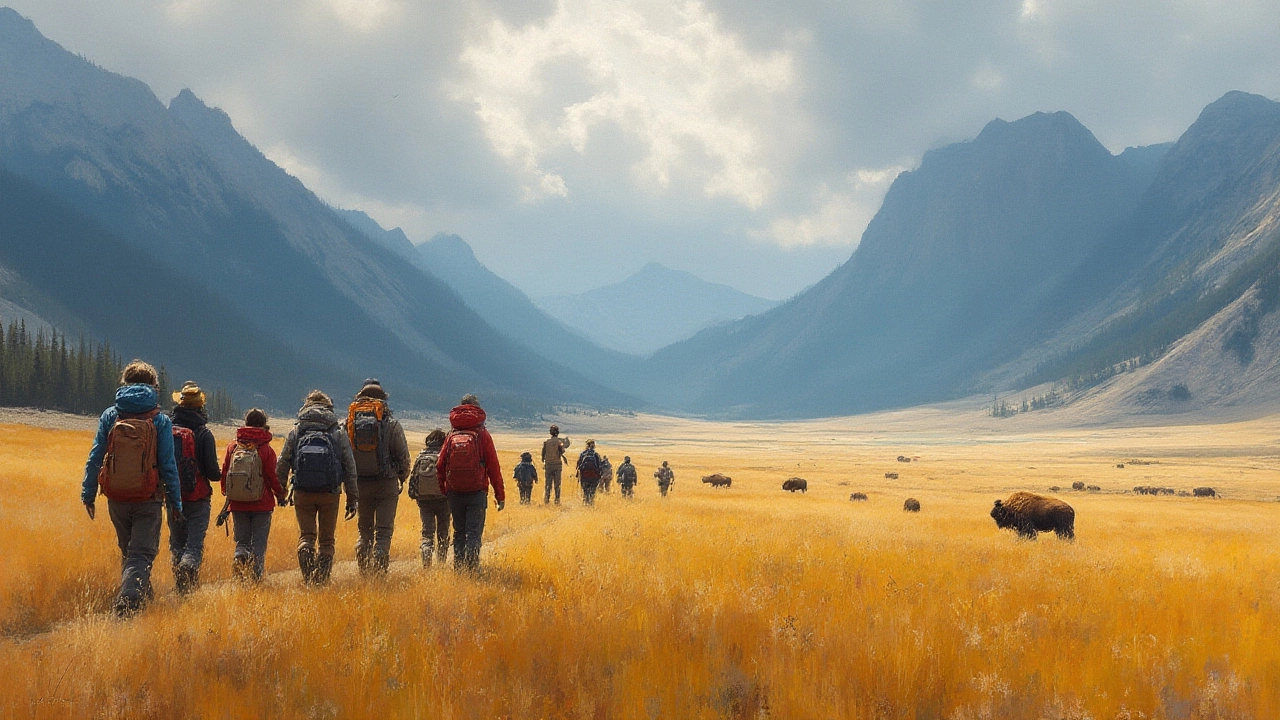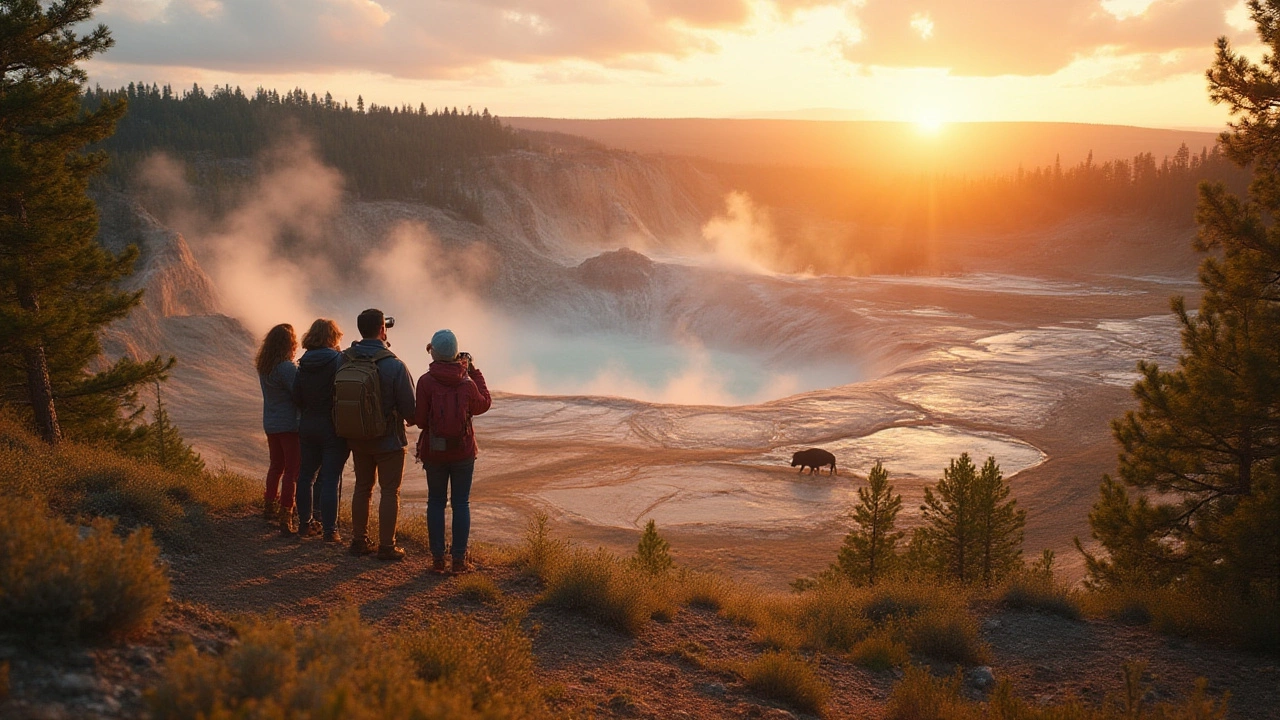Yellowstone National Park doesn’t just make the top of vacation lists—it sits there with serious confidence. If you thought America’s best vacation would be a big city or a sunny coast, think again. Yellowstone isn’t just a patch of trees and hot springs. It was the world’s first national park, signed into law by Ulysses S. Grant in 1872, and its wild energy has drawn curious travelers ever since. With millions of acres, geysers that blast sky-high, roaming bison blocking your path, and views that make you forget about your phone, it’s a reset button for your senses. Planning a trip doesn’t mean going off-grid totally—you’ll spot cell towers hidden among the pines, and yes, there’s Wi-Fi at the visitor centers, but step outside and you feel how wild it really is.
What Makes Yellowstone the Crown Jewel of American Travel?
There’s no place in the United States quite like Yellowstone National Park. First: the sheer scale. Yellowstone covers almost 3,500 square miles across Wyoming, Montana, and Idaho—that’s larger than the states of Delaware and Rhode Island combined. If you’re still picturing a glorified city park, erase that. This is a place with mountains that still surprise even locals, forests that stretch for miles, lakes larger than some countries’ entire cities, and a volcanic caldera humming under your feet. There’s a spirit of unpredictability in Yellowstone. Old Faithful shoots up like clockwork, but nearby, you might catch Steamboat Geyser—taller, louder, but famously fickle. Even NASA scientists monitor some of Yellowstone’s geothermal activity.
The wildlife feels straight out of a nature documentary, not a zoo. Yellowstone hosts the largest concentration of mammals in the lower 48. You can spot grizzly bears fishing, wolves tracking elk, herds of bison that sometimes cross the road without caring about your RV or rental car. Bald eagles, trumpeter swans, and coyotes all play their part. Even folks who aren’t exactly "outdoorsy" become wildlife fans for a week. No one forgets seeing big animals living as they have for thousands of years. There’s urgency, too: rangers say spring and fall offer action-packed drama, when predators and prey battle for survival.
If you’re interested in numbers and odd facts, Yellowstone is home to more than half of the world’s active geysers, thanks to the supervolcano below. There are over 10,000 geothermal features—hot springs, fumaroles, mudpots. Even the colors in places like Morning Glory Pool and Grand Prismatic Spring look painted by aliens, but it’s all due to bacteria thriving in superheated water. Bring your camera, or just stand and stare for a while. It’s easy to see why families, solo adventurers, and even grumpy teens find something that blows their mind in Yellowstone.
Planning the Perfect Trip: When, Where, and How?
Timing matters in Yellowstone. Summer (late June to early September) is the most popular—it’s warm, every park service is open, and you get full access to all roads and trails. But be ready for crowds. Some 4 million people visit every year, most during July and August. Mornings and evenings are your best shot for quiet paths and moody sunrise photos. Spring and fall are secret seasons here; spring brings baby bison and bear cubs, while September signals rut season for elk—that’s when males bugle loud enough to echo across valleys. Winter is for the bold. Picture steaming geysers under a white blanket, frozen waterfalls, and tours by snowcoach or cross-country ski. Less open, more magical.
Lodging can be a puzzle, but options fit every style. The most iconic is Old Faithful Inn, with its massive log beams, stone fireplaces, and lodge rooms often booked a year in advance. You don’t need to sleep indoors though—there are 12 campgrounds, many near rivers or forests. If you’re more into hot showers than starry nights, lodges like Lake Yellowstone Hotel or Mammoth Hot Springs Hotel offer historic vibes and modern comforts. Outside the park gates, the towns of West Yellowstone, Gardiner, and Cody feel like frontier outposts mixing cowboy charm with espresso and gift shops.
Getting there means airports in Bozeman, Billings, or Jackson, but a car is essential. Park roads twist, climb, and drop unpredictably. Fuel up before heading into the interior—there are only a handful of gas stations inside the park. Cell service? Patchy. Download maps before you go, and always carry extra snacks and water. Weather is a wild card: even midsummer, storms can blow in. Layers are your friend, from fleece in the morning to sunblock by noon. For serious hiking, bring bear spray (yes, it’s a thing), and always give wildlife serious space—rangers recommend at least 100 yards for bears and wolves. Want the lowdown on park conditions? Stop by a visitor center. Rangers love questions and usually have tips you won’t find anywhere else.

Top Sights and Activities: Yes, There’s More Than Just Old Faithful
Most first-timers rush to Old Faithful—the world’s most famous geyser—and sure, it’s worth it. It erupts about every 90 minutes, sending water up 100+ feet, sprayed with applause from a surprisingly international crowd. The neighboring Upper Geyser Basin has the highest concentration of hot springs and geysers in the world. But don’t stop there. Grand Prismatic Spring looks surreal enough to make Instagram crash—the rainbow colors are visible even from a satellite. You can get an overhead view from the Fairy Falls Trail, which honestly made even Gareth, who isn’t a hiking fan, gasp out loud.
Lamar Valley is where wildlife lovers geek out. Dawn is best: you might see wolves, herds of bison, pronghorn, and if you’re lucky, bears roaming wide open spaces. Bring binoculars. Hayden Valley offers a similar scene, a dream for photographers. The Grand Canyon of Yellowstone is the park’s showstopper—a mind-bending gorge carved by the Yellowstone River, complete with powerful waterfalls. Artist Point delivers one of the best views for a family picnic or solo meditation.
If you like hiking, you’ll never run out of options. Popular hikes include Mount Washburn (for sweeping views), Uncle Tom’s Trail (stairs, cliffs, and waterfall thunder), and Mystic Falls. For paddlers, Yellowstone Lake is adventure central, with kayaking and boat tours. Anglers come for cutthroat trout, though you need a park permit and should check regulations. Horseback rides, ranger programs, and even nighttime stargazing events round out the fun. I once joined a guided night hike to watch the stars without city lights, and it’s honestly as mind-blowing as the geysers.
Here’s a taste of how activities spread out through the year:
| Activity | Best Season | Family Friendly? | Notes |
|---|---|---|---|
| Wildlife Watching | Spring, Fall | Yes | Bring binoculars, go early morning |
| Hiking | Late Spring to Fall | Yes | Trails for all skill levels, check for closures |
| Geyser Tours | Summer | Yes | Boardwalks are wheelchair/stroller accessible |
| Fishing | Summer to Early Fall | Older kids/adults | Park permits required |
| Snowcoach/Snowmobile | Winter | Yes | Limited access, book early |
Essential Tips for a Yellowstone Adventure to Remember
Yellowstone rewards curiosity, but it also likes humble visitors. Bring patience. Roads can get clogged with animal traffic or construction, and sudden storms might throw plans out the window. Flexibility matters, and sometimes the best moments happen when you pause at a random lookout and realize you’re seeing the world’s largest active volcano at work. Having a backup plan—like a deck of cards, a good book, or snacks when traffic stalls—never hurts, especially for families with energetic kids or impatient partners.
People worry about safety, and yes, Yellowstone deserves respect. Don’t get close to animals, even for the perfect photo. Every year, rangers rescue folks who ignored danger signs or tried to pet bison for social media likes. Follow trail markers and don’t wander off boardwalks near thermal areas—the ground is surprisingly thin and water can be boiling hot. You’ll see signs everywhere for a reason. If you’re planning hikes, fill up water bottles before you go—altitude and dry air dehydrate fast. For serious explorers, check ranger-led programs, which sometimes let you see off-the-beaten-path sites or join research for a day.
Traveling with kids? Yellowstone is full of activity books, scavenger hunts, and Junior Ranger programs. Even picky teens end up wowed by the wildlife and weird landscapes. If you’re after "wow factor" moments, check out the park’s seasonal ranger talks or photo walks—rangers know all the secret angles for sunrise shots. When you leave the park, nearby towns like Cody offer rodeos, Western museums, and good pie. If you’re coming from a city, be ready for higher prices: think of it as a national park tax, but totally worth it for a memory-filled trip.
A big tip: cell service is pretty much nonexistent in most of the park. It can feel liberating, honestly. Set your phone on airplane mode, focus on the scenery, and remember details for storytelling later. Gareth tried to keep up with fantasy football scores here once—not a chance. On the upside, fewer digital distractions mean more stargazing, deep conversations around the campfire, or time to learn a new card game with family.
You don’t need to do everything to have the best vacation ever—sometimes just watching bison graze at sunset feels better than rushing to the next landmark. In Yellowstone, the world slows down, your problems shrink, and nature puts on a show that you don’t have to pay extra to see. Bring sturdy shoes, an adventurous heart, and leave with a story that gets better every time you tell it.
